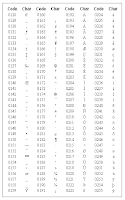
 Earlier today I needed to use the word cliché in a blog post. (Well, two posts, if you count this one.) Just one problem: my keyboard doesn't have an "accented-e" key. How could I insert that special character at the end of the word?
Earlier today I needed to use the word cliché in a blog post. (Well, two posts, if you count this one.) Just one problem: my keyboard doesn't have an "accented-e" key. How could I insert that special character at the end of the word?Most word processors offer an "insert symbol" feature, but if you're working elsewhere--text editor, e-mail client, Web form, etc.--you probably won't find such a tool.
Thankfully, Windows makes it pretty easy to insert all kinds of special characters, including symbols, accented letters, and so on.
One option is to use the Character Map utility, which has been bundled into Windows for as long as I can remember.
To run the program in Windows Vista or 7, click Start, type character, then click Character Map. In XP, I believe you can find it in the Start menu under Accessories.
Within the utility, click the font that most closely matches the one you're using (Arial is the default choice, and usually suitable for most applications), then scroll through the symbol list until you find the one you want. Click it, then click Select, and then Copy. Now just paste it in (by pressing Ctrl-V) wherever you need it.
 Of course, that's a bit overcomplicated if all you need is, say, an accented e. By holding down the Altkey and pressing 1, 3, 0 on my numeric keypad, Windows instantly inserts the desired é. For an em-dash (—), it's Alt-0151. (Note that if you're a laptop user, and your numeric keypad is overlaid on the main keyboard, you may need to hold down the Fn key as well.)
Of course, that's a bit overcomplicated if all you need is, say, an accented e. By holding down the Altkey and pressing 1, 3, 0 on my numeric keypad, Windows instantly inserts the desired é. For an em-dash (—), it's Alt-0151. (Note that if you're a laptop user, and your numeric keypad is overlaid on the main keyboard, you may need to hold down the Fn key as well.)Here's a more complete list of these Alt codes. Personally, i find committing a few frequently used codes to memory easier than slogging through Character Map.






